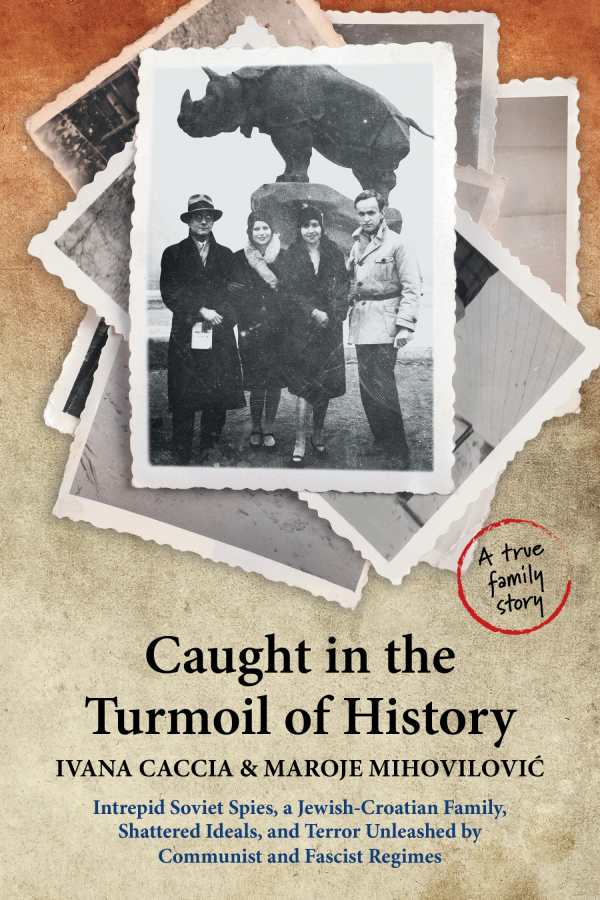Caught in the Turmoil of History
Intrepid Soviet Spies, a Jewish-Croatian Family, Shattered Ideals, and Terror Unleashed by Communist and Fascist Regimes
Moving at the engrossing pace of a novel, Caught in the Turmoil of History is an illuminating family biography.
With a timeline sprawling from the late nineteenth century to the Cold War, Ivana Caccia and Maroje Mihovilović’s expansive family biography Caught in the Turmoil of History covers Soviet espionage and antifascist movements.
Born in 1880, Vilma Miskolczy grew up in a prosperous Croatian Jewish family. Her intellectual curiosity and social consciousness conflicted with her father’s expectations that she become a wife and mother. When she did marry, she raised her children to appreciate knowledge, culture, and the exchange of political ideas. She also wrote fiction, translated poetry, and hoped to someday obtain a university degree.
Vilma’s sons, Branko and Slavko Vukelić, inherited their mother’s sociopolitical fervor. By the 1930s, both men had accepted Soviet spy assignments—Slavko in Paris, Madrid, and Lisbon, and Branko in Japan. Slavko’s radio technology expertise allowed the Soviets to establish long-distance communication networks, while Branko’s newspaper correspondent work served as a front for his covert activities. And in Croatia, journalist Ive Mihovilović married Vilma’s daughter, Elinor. Mihovilović had been detained by the Italian government for antifascist opinions, and his later defiance of Croatian nationalists resulted in further imprisonment and torture. Once released, he was jailed and interrogated due to suspicions that he was collaborating with the British military.
Narrative details illuminate the book: Upon glimpsing her future husband for the first time in a “lit-up cafe,” Vilma recalled his “thin face leaning over an open book.” Ive Mihovilović was entrapped by government agents and brought blindfolded to an interrogation cell. Slavko wrote loving yet coded letters to his wife using an alias, while Branko began an ardent pursuit of a Japanese woman he met at a Noh theater performance. In 1940s Zagreb, Vilma kept a vial of poison by her bed and planned to commit suicide if she was sent to a concentration camp. And intelligence warnings sent to Moscow from the head of Branko’s Tokyo spy group thwarted Adolf Hitler’s full advance into Russia.
Though grounded in historical realities with a variety of referenced sources, the book moves at the engrossing pace of a novel. As both historians and journalists as well as descendants of the Mihovilović and Vukelić families, the authors maintain balance, writing variously with detachment and pride. In recounting the clandestine actions and tragic deaths of the Vukelić brothers, the book notes the impassioned conviction behind much of the communist movement and how the promise of collective equality was like “an ideological mirage that dominated the twentieth century.”
Numerous images enhance the book’s content, including photographs of Vukelić and Mihovilović family members, pictures of the era’s ruling leaders, and reproductions of pertinent maps, monuments, and communications. Concise chapter headings and subheadings help to clarify a vast amount of information as the book’s focus shifts between regional and global conflicts and from Europe to East Asia and Russia. Further details regarding the postwar lives of the widows and children of the Vukelić brothers, along with the later publication of Vilma’s writings, add to the book’s saga-like flow.
With impressive scope, the family biography Caught in the Turmoil of History chronicles extraordinary ideological commitments and anguish during a century of upheaval.
Reviewed by
Meg Nola
Disclosure: This article is not an endorsement, but a review. The publisher of this book provided free copies of the book and paid a small fee to have their book reviewed by a professional reviewer. Foreword Reviews and Clarion Reviews make no guarantee that the publisher will receive a positive review. Foreword Magazine, Inc. is disclosing this in accordance with the Federal Trade Commission’s 16 CFR, Part 255.

